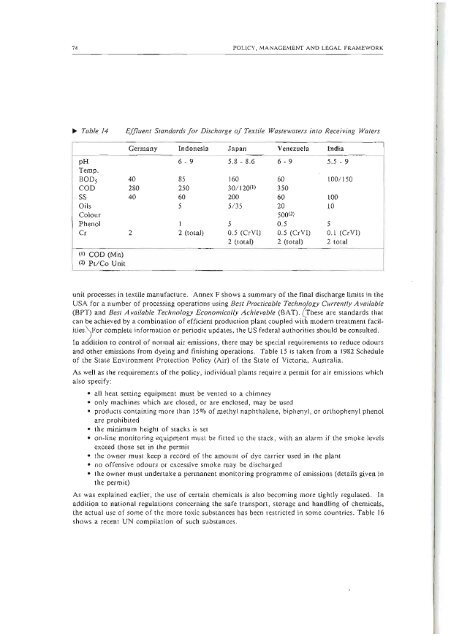Contributor, The Textile Industry and the Environment, UNEP
Contributor, The Textile Industry and the Environment, UNEP
Contributor, The Textile Industry and the Environment, UNEP
Create successful ePaper yourself
Turn your PDF publications into a flip-book with our unique Google optimized e-Paper software.
74 POLlCY, MANAGEMENT AND LEGAL FRAMEWORK<br />
unit processes in textile manufacture. Annex F shows a summary of <strong>the</strong> final discharge limits in <strong>the</strong><br />
USA for a number of processing operations using Best Practicable Technology Currently A vaifabfe<br />
(BPT) <strong>and</strong> Best A vai/able Technology Economically Achievable (BAT). (<strong>The</strong>se are st<strong>and</strong>ards that<br />
can be achieved by a combination of efficient production plant coupled with modern treatment facilities\For<br />
complete information or periodic updates, <strong>the</strong> US federal authorities should be consulted.<br />
10 acfclition to control of normal air emissions, <strong>the</strong>re may be special requirements to reduce odours<br />
<strong>and</strong> o<strong>the</strong>r emissions from dyeing <strong>and</strong> finishing operations. Table 15 is taken from a 1982 Schedule<br />
of <strong>the</strong> State <strong>Environment</strong> Protection Policy (Air) of <strong>the</strong> State of Victoria, Australia.<br />
As well as <strong>the</strong> requirements of <strong>the</strong> policy, individual plants require a permit for air emissions which<br />
also specify:<br />
• all heat setting equipment must be vented to a chimney<br />
• only machines which are closed, or are enclosed, may be used<br />
• products containing more than J5llJo of methyl naphthalene, biphenyl, or ortbophenyl phenol<br />
are prohibited<br />
• <strong>the</strong> minimum height of stacks is set<br />
• on-line monitoring equipment must be fitted to <strong>the</strong> stack, with an alarm if <strong>the</strong> smoke levels<br />
exceed those set in <strong>the</strong> permit<br />
• <strong>the</strong> owner must keep a record of <strong>the</strong> amount of dye carrier used in <strong>the</strong> plant<br />
• no offensive odours or excessive smoke may be discharged<br />
• <strong>the</strong> owner must undertake a permanent monitoring programme of emissions (details given in<br />
<strong>the</strong> permit)<br />
As was explained earlier, <strong>the</strong> use of certain chemicals is also becoming more tightly regulated. In<br />
addition to national regulations concerning <strong>the</strong> safe transport, storage <strong>and</strong> h<strong>and</strong>ling of chemicals,<br />
<strong>the</strong> actual use of some of <strong>the</strong> more toxic substances has been restricted in some countries. Table 16<br />
shows a recent UN compilation of such substances.

















